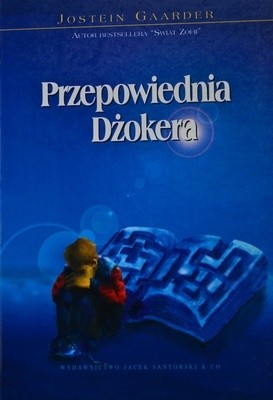„Przepowiednia Dżokera”, Jostein Gaarder "The Solitaire Mystery", Jostein Gaarder
Masz 12 lat. Żyjesz tylko z „ojczulkiem”, matka opuściła ciebie i jego 8 lat wcześniej. Nagle ojciec postanawia ją odnaleźć – i przy okazji pomóc jej odnaleźć siebie, bo właśnie taki powód odejścia podała: chciała „się odnaleźć”. W wakacje wyjeżdżacie więc z rodzinnej Norwegii. Kierunek: Ateny, bo jedyne, co teraz wiecie na pewno, to to, że tam właśnie teraz przebywa. W małym niemieckim miasteczku dostajesz lupę z kawałka szkła – daje ci ją dziwaczny karzeł. W jakiś czas później piekarz w tej samej miejscowości wręcza ci 4 bułki, a w jednej z nich… miniaturową książeczkę! Niewiarygodne? Może. Ale właśnie tak zaczyna się książka „Przepowiednia Dżokera” Josteina Gaardera. Czytając „bułeczkową książeczkę” – potajemnie, zgodnie z życzeniem piekarza – Hans Thomas poznaje historię pewnego człowieka, który z kolei opisuje to, co usłyszał od swojego opiekuna. I nie przesadzę, jeśli powiem jedno: o ile miewam dość… specyficzne sny, o tyle żaden z nich nie umywa się do tego, co główny bohater powieści Gaardera przeczytał w swoim znalezisku. Nie chcę zepsuć przyjemności czytania. Zdradzę więc jedynie, że Frode (postać, o której narratorowi „bułeczkowej książeczki” opowiadał jego opiekun) dosłownie „miał asa”, ale nie w rękawie, tylko… w miasteczku. I nie jednego, lecz cztery – i wszystkie inne karty też. Jak to możliwe, pytasz? Nie tak szybko, mówi Dżoker. Tak, tak! Trzeba zwolnić tempo, mówi Dżoker. Tak wiele pytań się nasuwa. Czy „bułeczkowa książeczka” odnosi się wyłącznie do wydarzeń zupełnie niezwiązanych z Hansem Thomasem? A może… może dzięki niezwykłej opowieści chłopiec dowie się czegoś o sobie? Czym jest tytułowa „Przepowiednia Dżokera”? Czy Hans Thomas odnajdzie swoją matkę i pomoże jej odnaleźć zagubiony sens życia? Tak, odpowiedzi na te wszystkie pytania są w „Przepowiedni Dżokera” Josteina Gaardera. Trzeba tylko odpowiednio szukać…

Zdjęcie okładki polskiego tłumaczenia (obraz z grafiki Google)
Picture of the cover of the Polish translation (image from Google graphics)
You’re 12 years old. You live only with your ‘daddy’, mother left you and him 8 years earlier. Suddenly, the father decides to find her – and on occasion to help her find her feet, as this was the reason she gave for going away: she wanted to ‘find her feet’. So during the holiday, you leave natal Norway. Direction: Athens, because the only thing you know now is that this is where she is staying now. In a small German town, you get a magnifying glass made of a piece of glass – a strange dwarf gives it to you. Sometime later a baker in the same town hands you 4 buns and… a miniature book in one of them! Unbelievable? Maybe. But that’s how Jostein Gaarder’s book ‘Joker’s Prophecy’ begins. While reading ‘the sticky bun book’ – in secret, according to the baker’s wish – Hans Thomas gets to know the story of some man, who in turn describes what he heard from his guardian. And I won’t exaggerate if I say one thing: even though I’ve got quite… peculiar dreams, none of them compares to what the main character of Gaarder’s novel read in his finding. I don’t want to spoil the pleasure of reading. I’ll just say that Frode (the character about whom the narrator of ‘the sticky bun book’ is told by his guardian) literally ‘has an ace’, but not ‘up his sleeve’, but… in the town. And not one, but four – and all the other cards too. You’re asking how it is possible? Not so quickly, says Joker. Yes, yes! You’ve got to slow down the tempo, says Joker. So many questions arise. Does ‘the book from the bun’ only refer to the events that are completely unrelated to Hans Thomas? Or maybe… maybe thanks to the extraordinary story the boy will get to know something about himself? What is the title ‘Solitaire Mystery’? Will Hans Thomas find his mother and help her find the lost sense of life? Yes, the answers to all of those questions are in Jostein Gaarder’s ‘The Solitaire Mystery’. One just needs to search properly…



